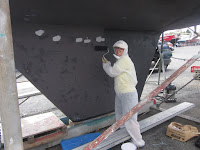Whangerei is a mecca for cruisers waiting out the cyclone
season because absolutely every maintenance and repair project can be completed
with the vast array of professional boat services and supplies available
here. In addition, marinas allow owners
to do major work on site (not common in U.S.
marinas), and electrical connections are accessible for the first time since Mexico . The air
is filled with sounds of sawing, drilling and sanding; cockpits are filled with
tools and parts; support and camaraderie abound.
No need for details, but here is a photo gallery with before
& after shots of some of our more visible projects:
 |
| Rusty anchor chain |
 |
| Even caulked chain plate covers can let water inside the boat, so Art re-bedded them with tar worms and heavy-duty marine sealant |
 |
| Now looking shiny & new on top; more important is the improved seal below |
 |
| We checked and cleaned chain plate bolts throughout the interior... |
It's a luxury to cross tasks off the To Do List faster than
they get added. Not only did our stay in Whangarei allow for that, it also
enabled us to complete a long-desired upgrade: remodeling both heads
(mariner-speak for bathrooms).
 |
| Old counter & faucets |
 |
| Paint peeling off walls |
 |
| Step 1: Forward head, before |
 |
| Step 2: Slice leg while using foreign grinder to cut granite |
 |
| Steps 3 & 4: Complete cutting granite with tried-and-true grinder, and find plumbing solutions that don't leak |
 |
| Steps 5-10: Scrape, sand, prime & paint walls; wood panel (cut & varnished) added in some places |
Step 12, not pictured:
A Head Warming Party, in which everyone agreed
(including Art) that the granite was worth the gash!
 |
| Step 13: Leg gradually heals |
Another multi-step process was a haulout for bottom paint and inspections. We lived "on the hard"--when the boat is on a stand rather than in the water--for two weeks. Environmental regulations require that licensed professionals do the power washing & bottom sanding, but we could do everything else (tape along the water line, fill sanded areas with epoxy and grind them smooth, apply specialized primer and two coats of anti-fouling paint that helps keep marine growth from attaching to the hull).
A few of those steps are here:
A few of those steps are here:
 |
| Alien Art, sanding epoxied areas |
 |
| Nancie painting the keel |
 |
| I didn't get a photo of Art replacing a through-hull (one of the many holes necessary in the bottom of the boat), but here he is after a cleaning operation on the propeller |
 |
| A week later, bottom paint was done. What a beauty! |
 |
| Living on the hard means having to climb a ladder to get on/off the boat |
 |
| We were sure glad to get back in the water! |
And here are some single photos, for projects that didn't have visible before/after changes--or for which I simply forgot to take a 'before' shot!
 |
| New engine room insulation (too bad I forgot a before picture of this one! |
 |
The engine alternator hadn't given us any problems,
but to ward off potential issues,
we had it inspected & rebuilt
|
 |
| Replacing the watermaker's booster pump |
 |
| Old solar panels (left) were okay, but new ones (right) made a huge improvement |
 |
| Art & Bill Grimm wrangling a larger panel (one of three) onto the deck |
 |
| New regulator for the solar panels installed |
 |
| Old running backstays (left) were wire, and possibly not okay; new ones (right) are a high strength rope called Dyneema |
Projects are never over, of course, but we feel great about getting so many major ones completed.
Now it's time to do more sight-seeing! Our good friends Marilee & Bill Grimm are visiting from Oregon, so we'll take time off to do some inland touring with them. (Luckily for readers, the next blog post will have pretty pictures again.)






